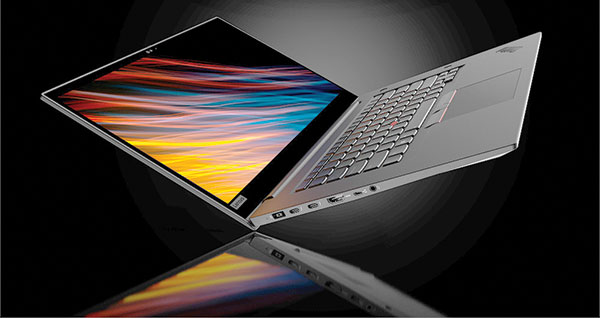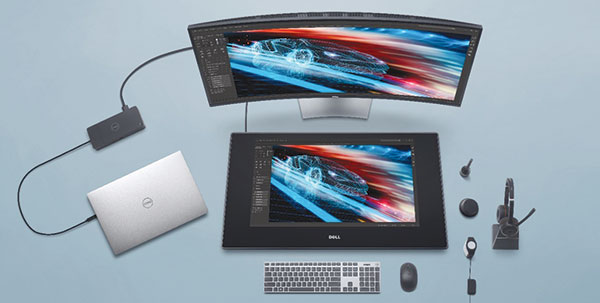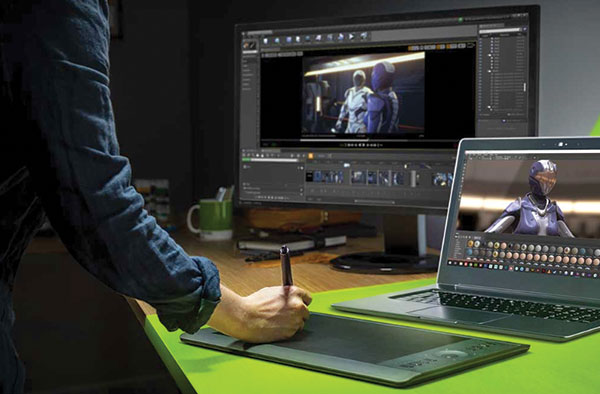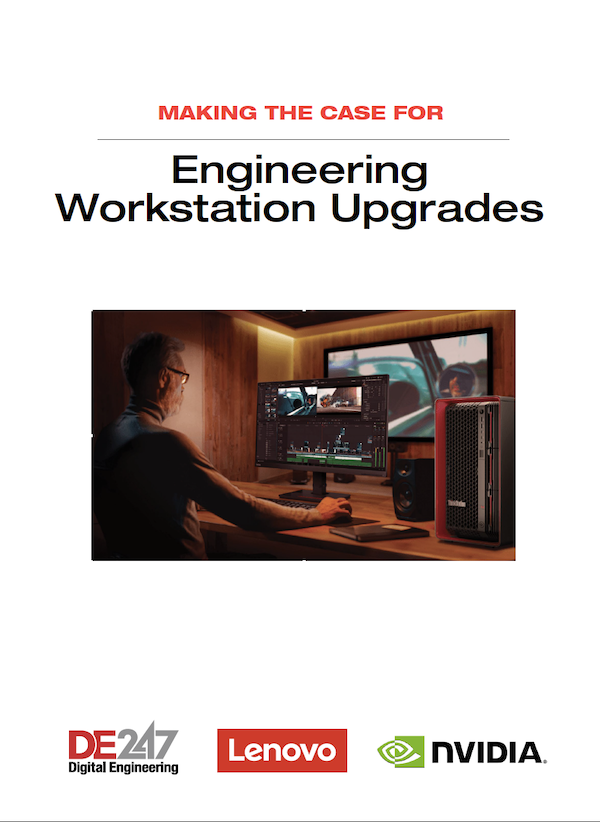Mobile Workstations Continue to Rise
Demand is driven by the desire to have as much computing power as possible at hand 24/7.

Lenovo has updated its ThinkPad P1 with a new chassis. Image courtesy of Lenovo.
Latest News
December 1, 2019
The mobile workstation market continues to be a bright spot for computer vendors. The price/performance curve bends in the customer’s favor, as each generation of key components continue to improve while prices generally remain steady.
The workstation industry as a whole has never been stronger. In the second quarter of 2019, workstation sales set an industry record with more than 1.6 million units shipped (desktop and mobile), according to Jon Peddie Research (JPR). All vendors contacted by Digital Engineering agree that mobile workstation sales continue to grow as a share of the entire workstation market.
Demand is being driven by a variety of factors, including the desire to have as much computing power as possible at hand 24/7, the continued demographic shift toward “work anywhere” arrangements, and increasingly powerful specs becoming available to mobile workstations.
A leading industry analyst says it is no surprise mobile workstations continue to expand their share of the larger workstation market. “Moore’s Law is not dead,” says Jon Peddie, president of JPR. “Maybe it’s not running as fast, but it is alive and well. Proof of that is the advances made in shrinking semiconductors and making them less power hungry in the process. Screens have gotten to 4K, and some mobile PCs are even offering cellular always-connected capabilities.”
But, the analyst warns of buyer beware. Just because a mobile computer is labeled or branded as a mobile workstation, it may not be one. “Use the laws of a workstation,” Peddie says:
- must have a workstation-class CPU such as an AMD Ryzen-WS or Intel Xeon or Core i7-i9;
- must have a workstation-class graphics processing unit such as an AMD Radeon Pro or NVIDIA Quadro;
- must have error-correcting code memory;
- must have application-specific, vendor-certified drivers;
- must have Windows Pro or an equivalent Linux operating system;
- should have a minimum of 32 GB RAM; and
- must be ultra-reliable.
In recent years, most workstation vendors have introduced tiny desktop workstations. Although they are growing in popularity, they are not reducing demand for mobile workstations.
“Desktops are shrinking, and the line is blurring between fixed and mobile workstations,” says Mano Gialusis, senior product marketing manager for Dell. “The big differentiation continues to be the battery.”

As mobile workstations become more powerful, they are often required to replace desktop workflows. The Dell Precision 5540 can support multiple monitors and devices. Image courtesy of Dell.
The thin-and-light form factor continues to grow in popularity, says Lane Jesseph, a mobile workstation segment lead at Lenovo. Designing workstation performance is a “tricky balance” between performance and the power required. “The laws of physics haven’t changed,” Jesseph says. “Customers in the workstation space understand this much power in this chassis limits expandability.”
Lenovo’s popular ThinkPad P1 mobile workstation has a new chassis. “We built it to find a better compromise,” says Jesseph. “It is based on a different design philosophy: Design the chassis first, then decide how much horsepower we can put in.” This second-generation mobile workstation offers a choice of several Intel processors and adds a Dolby Vision HDR OLED 4K UHD display option.
The Rise of RTX
Display technology has been an interesting segment for mobile workstations. Vendors agree that 4K and UHD are settled standards, and most upgrades from large customers now specify this level of display specs. “The end of the pixel wars is in sight,” says Lenovo’s Jesseph. Now customers want better pixels, wider color gamut and high-dynamic range.
Mobile workstation vendors were delivered an early Christmas present this year with the release of NVIDIA’s RTX technology in a mobile form factor. This new standard offers real-time photorealistic rendering, AI acceleration and 8K video support for content creation including virtual reality. Dell, HP, Lenovo and MSI are among vendors now shipping new mobile workstations based on RTX technology. Software vendors offering certification on RTX include Autodesk, Dassault Systèmes, Siemens, PTC, Chaos Group, ANSYS and Schlumberger.
The RTX quantum leap for video is accelerating a shift in how mobile workstation customers perceive the market, says Dell’s Gialusis. Historically, the mobile workstation market had entry-mid-high segments, “but the lines are blurring. Performance is moving down the stack,” he says.
Today’s entry-level workstations now have better performance than the mid- or high-grade mobile workstations of only a couple of years ago. In Dell’s case, this means past customers who were drawn to enterprise or gaming mobile computers are now buying entry-level mobile workstations. “Some customers are just now realizing they can afford the extra power and performance” that workstations offer, he adds.

Thin and light continues to be a popular form factor for mobile workstations as powerful components shrink, including the HP ZBook 14 and ZBook 15. Image courtesy of HP.
Another shift in the mobile workstation market that will continue to rise in the year ahead is the use of touchscreens. At HP, of all their mobile workstations, there is “only one model that does not have touch,” says Marie Breedlove, HP’s worldwide product manager for the ZBook mobile workstation line. [For more on the new ZBook, see our review on page 42.]
HP has partnered with Wacom to extend touch even further, offering screen-based pen control for several models. Wacom products were originally popular for creative and aesthetic applications, but HP sees the technology gaining ground in more technical applications.
HP is also extending the mobile workstation into the realm of the tablet. The HP ZBook x2 has a detachable screen; all the computer power is in the screen side. At SolidWorks World 2019, HP demonstrated the x2 running SolidWorks.
Virtually Cloudy in the Enterprise
Even within their engineering departments, enterprise customers continue to expand their use of virtualization technology.
“Virtual applications, virtual desktops and cloud-based applications all support a flexible and mobile workforce,” notes Tim Lawrence, vice president of operations and engineering for BOXX Technologies.
Virtualization is a popular way to maintain secure operations, and intellectual property when employees—and their mobile workstations—leave the building. “Many businesses are allowing more work from home,” and in other ways encouraging geographically dispersed work, he adds.

Workstation computers have traditionally been used for graphics-intensive applications, but BOXX sees rising demand for mobile workstations for artificial intelligence fields, including data science and machine learning. Lawrence says the new generation of engineering software tools, which put more power in the designer’s hands, such as ANSYS Discovery Live, are also driving mobile workstation sales.
What hasn’t changed in the workstation market is the implicit promise of a longer product life for workstations compared to consumer or enterprise computers.
“The long life of mobile workstation models is still very important,” says HP’s Breedlove. “A company with 50 employees wants everyone on the same computers.” If the company needs to increase employees, “they don’t want the new people on different computers,” Breedlove adds.
In the consumer and enterprise lines, the same model name may be listed on the price sheet, but the exact configuration could be refreshed. With workstations, the specs stay the same for the entire life of the model. “Our sales representatives help our customers manage their lifecycle requirements, to be sure the customer gets their buys right,” Breedlove says. “We offer assurance the model they need will be around.”
More Ansys Coverage
More BOXX Technologies Coverage
More Hewlett Packard Coverage
More Jon Peddie Research Coverage
More Lenovo Coverage

Subscribe to our FREE magazine, FREE email newsletters or both!
Latest News
About the Author
Randall S. Newton is principal analyst at Consilia Vektor, covering engineering technology. He has been part of the computer graphics industry in a variety of roles since 1985.
Follow DE






